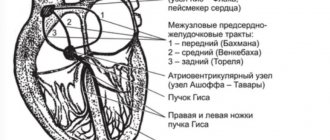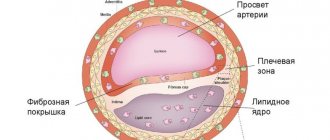- Healthy Heart Library
- Prevention of cardiovascular diseases
Almost all diseases are easier to prevent than to treat later, and cardiovascular pathologies are no exception. In recent years, the frequency of such diseases has been steadily increasing, which is not surprising: most diseases of the heart and blood vessels are rightly considered by doctors to be diseases of civilization. They find nutritious soil in the form of the lifestyle of modern man with his poor nutrition, insufficient physical activity, acute and chronic stress. Therefore, doctors never tire of reminding us of the enormous role of timely prevention of heart disease, especially in patients at risk who are prone to such diseases. Preventive measures help prevent diseases, improve the patient’s quality of life, and prolong it.
Statistics on heart and vascular diseases
In Russia, heart and vascular diseases remain one of the main causes of mortality (up to 47%). However, in recent years there has been a gradual decrease in both the overall incidence of such diseases and mortality from them. Doctors attribute this both to the success of mass medical examinations and the increased effectiveness of modern treatment of heart diseases, and to increased public awareness of the importance of preventing such pathologies.
Preventative measures have been proven to protect against cardiovascular disease more effectively than any other measure. This is proven by research by epidemiologists: for example, a 50% reduction in the incidence of mortality from coronary heart disease is associated precisely with complex and active prevention, and only 40% with the improvement of methods of treating this pathology.
Treatment
Treatment methods for heart disease:
- Conservative (integrated approach) - the patient is prescribed a special diet, prescribed medication, and lifestyle adjustments. Therapeutic courses are also used in sanatoriums.
- Surgical – if the conservative method is ineffective or unacceptable. During the operation, the heart valves and blood vessels are replaced, and various types of organ damage are eliminated.
To avoid long-term treatment for heart disease or complex, expensive surgery, prevention is necessary. This should not become a periodic set of events, but an integral part of life.
Major heart and vascular diseases
Diseases of the heart and blood vessels constitute a very large group, so the list below represents only the most basic and common pathologies:
- IHD (coronary heart disease), as well as its complications - heart attack, angina pectoris, cardiosclerosis;
- arterial hypertension;
- heart rhythm disturbances;
- congenital and acquired heart defects;
- heart failure;
- infectious and inflammatory pathologies of the heart - endo-, myo-, pericarditis;
- inflammatory vascular pathologies;
- atherosclerosis;
- systemic vascular pathologies;
- bleeding disorders.
Classification of CVD
The most common, socially significant CVDs include:
- Hypertension is a persistent increase in blood pressure.
- Atherosclerosis is the blocking of the arterial lumen by cholesterol plaques. Damage to the coronary vessels leads to coronary heart disease, the arteries of the head and neck to ischemia (lack of blood supply) to the brain, and large arteries of the legs to ischemia of the limb.
- Coronary heart disease is a disorder of the blood supply to the myocardium caused by obstruction (narrowing of the lumen) of the coronary arteries. The acute form of the disease is myocardial infarction.
- Cardiac arrhythmias are disturbances in heart rhythm and conduction.
- Inflammatory heart diseases are lesions of an autoimmune or infectious nature that affect the pericardial sac, muscle layer or internal connective tissue lining of the heart - pericarditis, myocarditis, endocarditis, respectively. Rheumatic carditis is most often recorded.
- Cerebrovascular pathologies are diseases of the blood vessels of the brain. An acute form of circulatory disturbance in the great vessels of the head and neck is ischemic stroke (cerebral infarction). If the integrity of the vascular wall is damaged or incompetent, a hemorrhagic stroke (bleeding in the brain) develops.
- Thromboangiitis obliterans is a progressive closure of the small arteries of the legs (first due to spasm, then associated thrombosis), accompanied by ischemia of the limb.
- Venous thrombosis and pulmonary embolism (PE) are complete or partial closure of the lumen of the veins or the main artery responsible for the blood supply to the lungs with a blood clot.
Significantly less common:
- congenital and acquired heart defects;
- heart tumors;
- systemic vasculitis;
- thromboembolism of the arteries of the systemic circulation (peripheral, mesenteric and others).
Causes of cardiovascular diseases
The main cause of cardiovascular pathology is the lifestyle of a modern person. Insufficient physical activity, poor nutrition with a predominance of animals, “heavy” fats and “fast” carbohydrates, refined and canned foods, and fast food lead to increased blood cholesterol levels and metabolic disorders. The acute and chronic stresses that modern people face also contribute.
In addition, do not forget about bad habits: smoking and drinking alcoholic beverages negatively affect the condition of the walls of blood vessels and blood flow. All this together leads to the formation of certain pathologies: atherosclerosis, ischemic heart disease, hypertension and many others.
Causes of CVD development
Damages of the heart and blood vessels are multifactorial pathologies - they arise against the background of several predisposing conditions. The main cause of the vast majority of cardiac and cerebrovascular pathologies is an increase in the level of low-density lipoproteins (LDL) in the blood. An increase in their concentration leads to excess cholesterol, which forms plaques on the walls of blood vessels, narrowing their lumen.
An important role in the development of CVD is played by hereditary predisposition - those at risk are those whose immediate relatives (brothers, sisters, parents) have the corresponding disease. The likelihood of developing cardiovascular pathologies is increased by diabetes mellitus, kidney and thyroid diseases, infections (most often streptococcal - sore throat, scarlet fever, erysipelas, impetigo). In women, the triggering factor is conditions accompanied by hormonal changes: more often - menopause, less often - pregnancy.
The leading risk factors include lifestyle features and their adverse consequences:
- Physical inactivity. A sedentary lifestyle negatively affects the condition of the vascular walls and myocardium, increases the risk of thrombosis, and contributes to the occurrence of excess weight and diabetes.
- Diet errors. Increased salt consumption increases the risk of hypertension, excess sweets in the diet leads to diabetes, obesity, and increases LDL levels. Abuse of animal fats contributes to the development of atherosclerosis. Lack of proteins, microelements (potassium, magnesium, iron, copper, zinc, selenium), most vitamins negatively affects the condition of blood vessels and the heart, and myocardial function.
- Psycho-emotional stress. Acute stress is accompanied by the release of adrenaline, which increases the load on the heart, which can lead to myocardial infarction. Chronic stress is accompanied by increased levels of cortisol, which slows down the production of growth hormone. Deficiency of this hormone in adults indirectly provokes the development of CVD.
- Excess body weight is usually a consequence of the influence of the factors listed above. Obesity is a favorable condition for the occurrence of thromboembolism, increases LDL levels, and creates additional stress on the heart and blood vessels.
- Bad habits. Each episode of alcohol abuse leads to a decrease in the contractile function of the myocardium and impairs blood circulation. Tobacco smoking leads to increased blood pressure, provokes blood clots, the formation of atherosclerotic plaques, and increases the risk of arrhythmia.
Often one primary CVD leads to the development of another. Thus, atherosclerosis and arterial hypertension are the main causes of coronary heart disease, rheumatic carditis often leads to acquired defects, cardiac arrhythmias, and heart rhythm disturbances lead to thromboembolism of the arteries supplying blood to the limbs and internal organs.
Primary and secondary prevention of heart and vascular diseases
Rational prevention of cardiac pathology is always comprehensive. It should include rationalization of nutrition, physical activity, stress management, giving up bad habits, and regular medical examinations. All of these measures can be classified as primary prevention measures, which are taken when the risk of heart disease is low. In the presence of pronounced predisposing factors to heart disease, it is necessary to use secondary prevention measures. Among them are weight loss, normalization of cholesterol and blood sugar levels, lowering blood pressure, and normalizing heart rate.
Nutrition to prevent heart disease
In order to ensure effective prevention of cardiovascular diseases, it is necessary to ensure a balanced diet. In this case, the best solution would be split meals in small portions 4-5 times a day; this is much healthier for the heart than two dense meals of large quantities of food. You should have dinner no later than 3 hours before going to bed.
If you are already overweight, you should adhere to a low-calorie diet, but calorie restriction should not be very strict. You can’t go hungry: a sharp restriction of the body’s diet leads to a deficiency of nutrients, including for the heart muscle.
Basic principles of nutrition for the prevention of heart disease:
- limiting “fast” carbohydrates - sugar, baked goods, sweets; preference should be given to dried fruits, honey, whole grain bread;
- The consumption of animal fats is limited; it is better to give preference to olive and flaxseed oil. It is better to exclude palm and coconut oil;
- limit the consumption of caffeinated drinks;
- salt consumption is limited, it is better to exclude sausages and smoked meats, pickles;
- It is better to completely eliminate the consumption of alcoholic beverages;
- from meat it is better to choose lean veal, chicken, rabbit, turkey;
- nuts, flax seeds, sesame are useful;
- It is recommended to consume large amounts of fiber in the form of vegetables, fruits, and herbs;
- healthy sea fish and seafood, fish oil in the form of supplements;
- It is recommended to consume fermented milk products daily, which stimulate digestion and saturate the body with calcium.
- Fast food, semi-finished products, products with an abundance of flavor enhancers and preservatives should be completely abandoned.
Dishes should be boiled, baked, steamed. It is recommended to completely exclude fried foods. It is necessary to drink a sufficient amount of liquid - up to one and a half to two liters per day. At the same time, strong tea or coffee should be avoided, preferring still mineral water, herbal tea, compote, fruit juice.
Physical activity to prevent heart disease
Modern man is becoming less and less mobile: work, thanks to the automation of processes, requires less and less effort, transportation takes him to his place of work, even laundry, washing dishes, turning on the TV no longer require real physical activity. Sedentary weekdays flow into similar weekends spent watching TV. This lifestyle contributes to excess weight gain and poor blood circulation in the tissues. In order to avoid developing heart disease, you need to increase physical activity. The best solution would be reasonable exercise in the fresh air - walking, Nordic walking, skiing, cycling. Cardio exercises in the gym (exercise bike, treadmill) are also useful. Swimming and gymnastics have proven themselves well.
An important condition for such physical activity: it should not be excessive and should not provoke overwork.
At the same time, it is important that the loads be regular: it is much better to walk 2-3 km every day, that is, half an hour, than to arrange a grueling two-hour session in the gym.
Prevention of cardiovascular diseases in children
It is better to protect the health of the heart and blood vessels from the first days of a child’s life. This means that from the first months of life it is important to accustom your baby to gymnastics - naturally, appropriate for his age, and proper nutrition. By the way, eating habits established in childhood are sometimes very difficult to change, and a child accustomed to an abundance of baked goods and sweets will most likely suffer greatly in adulthood due to the need to follow a diet.
Key points for the prevention of heart and vascular diseases in children:
- rational nutrition and maintaining normal body weight;
- sufficient physical activity, sports;
- prevention of bad habits;
- regular medical examinations.
The example of parents plays a huge role: if they eat right, lead a healthy and active lifestyle, the baby will have the right example before his eyes, which he will unconsciously adhere to.
Preventing heart disease in older people
Natural age-related changes in the body inevitably affect the cardiovascular system. The walls of blood vessels lose their elasticity, atherosclerotic plaques appear on them, blood pressure rises, and blood flow decreases. The risk of thrombosis of peripheral vessels increases, including coronary (myocardial infarction), brain (ischemic stroke), retina (blindness), etc. Therefore, in old age, it is especially important to regularly visit a cardiologist - at least once every six months starting from 40-50 years.
In addition to examining a doctor, it is recommended to:
- ECG, including with stress (for men);
- blood test for lipids;
- coagulograms.
In addition, you need to regularly monitor your blood pressure using a household tonometer.
Diagnostics
The diagnosis of pathology of the heart or blood vessels is established based on the results of a clinical examination, a patient interview, and a number of instrumental and laboratory tests. The main instrumental methods used in the diagnosis of CVD:
- Electrocardiography (ECG) is an electrophysiological method used in the diagnosis of arrhythmias and myocardial infarction. A variation is Holter monitoring, which allows you to take readings throughout the day using a portable device.
- Echocardiography (EchoCG) is an ultrasound method of examining the heart that reveals both functional disorders and structural disorders (tumors, vegetations, defects, inflammation). It is also prescribed for suspected pulmonary embolism.
- MRI, CT (magnetic resonance, computed tomography) of the brain - used in the diagnosis of strokes.
- Ultrasound scanning and dopplerography of blood vessels - used in the diagnosis of chronic cerebrovascular accidents and peripheral vascular diseases.
Laboratory tests include:
- In the diagnosis of inflammatory heart diseases - biochemical study of the protein spectrum, general blood test, bacterial blood culture.
- In the diagnosis of atherosclerosis - a biochemical test for the level of cholesterol, LDL, triglycerides.
- If any CVD is suspected, a coagulogram is performed.
Modern equipment allows diagnosis without invasive procedures.
Drugs for the prevention of cardiovascular diseases
Secondary prevention of cardiovascular diseases with the help of pharmaceuticals is extremely important, especially for people prone to such pathologies. For preventive purposes, complexes of vitamins and minerals, drugs with antithrombotic effects, and drugs that lower blood cholesterol levels can be taken. These drugs are usually sold without a prescription, but it is recommended that you consult a doctor before taking them.
Riboxin for the prevention of heart pathologies
Riboxin stimulates the supply of tissues, including the heart muscle, with oxygen, stimulates blood circulation, and normalizes heart rhythm. Taking the drug as a course course, treatment is prescribed by a doctor. There are contraindications, including gout and kidney failure.
Acetylsalicylic acid for the prevention of heart disease
Taking acetylsalicylic acid helps improve blood flow and has an antithrombotic effect. As a rule, for the prevention of heart disease, acetylsalicylic acid is produced in a special cardio dosage. To achieve the effect, long-term or continuous use is required. There are contraindications for use, including gastritis, gastric and duodenal ulcers.
Magnesium for the prevention of heart disease
Magnesium is a mineral that plays an important role in the health of the cardiovascular system, it helps stabilize the heart rhythm and lower blood pressure. Magnesium is included in many drugs for the prevention and treatment of cardiac diseases; your doctor will help you choose the optimal drug.
Fasostabil for the prevention of heart disease
Fasostabil is a complex drug in which the main active ingredient, acetylsalicylic acid, is supplemented with magnesium hydroxide. Thanks to this, the irritating effect of acetylsalicylic acid on the walls of the stomach is significantly reduced, in addition, magnesium has a mild hypotensive and stabilizing effect. The use of Fazostabil is preferable to taking regular acetylsalicylic acid; the drug is well tolerated.
Preventive measures in old age
The approach of old age causes changes in the body, which also affect the circulatory system. The vessels become rigid and fragile, cholesterol plaques form in them, gradually narrowing the lumen of the coronary arteries. The blood thickens, its flow slows down, as a result of which the nutrition of all tissues of the body deteriorates. The risk of blood clots increases.
Consultations with a cardiologist every six months are a necessary preventative measure for the heart after 40 and 50 years. It is advisable to conduct the following examinations:
- An ECG should be taken; a stress electrocardiogram is recommended for men.
- Take a blood lipid test every year.
- Monitor blood clotting.
- Buy a blood pressure monitor for home and measure your blood pressure regularly.
https://profilaktika-zabolevanij.ru/organy/serdce/
Herbal medicine for the prevention of heart disease
Herbal medicines and various traditional medicines are available to everyone. It is important to remember that herbal remedies are only good as part of comprehensive prevention - they cannot replace a balanced diet or quitting smoking. In addition, individual intolerance or contraindications may also occur to herbal remedies. Among the “folk” remedies for the heart are:
- garlic - it should be consumed raw with food, as well as in the form of tincture, garlic oil;
- chokeberry, ground with honey;
- a mixture of persimmon and turnip juices with honey;
- a mixture of radish, carrot, beet juices with honey;
- a mixture of carrot juice with vegetable oil;
- a mixture of honey and royal jelly;
- hawthorn in the form of tea, tincture.
Ten steps to a healthy heart!
Ten preventive measures that are simple and accessible to absolutely everyone: save this list and let your heart be healthy!
- Step 1 - rational nutrition. In your daily diet, it is recommended to minimize the consumption of fatty foods, fried foods, and reduce the consumption of salt, sugar, and caffeine. It is recommended to give preference to sea fish, lean poultry, whole grain bread, and consume a sufficient amount of fiber-rich vegetables and fruits.
- Step 2 - normalization of body weight. Excess weight automatically becomes a burden for the heart and blood vessels, in addition, it reflects an unfavorable balance of cholesterol in the body. It is known that excess body weight also contributes to increased blood pressure. If you have extra pounds, you need to reconsider your diet and increase physical activity. By the way, not only body weight as such plays a role, which should be normal (Quetelet body mass index is not higher than 28.0), but also waist circumference - no more than 88 cm in women and no more than 102 cm in men.
- Step 3 - increase physical activity. Physical inactivity is the enemy of the heart and blood vessels, and for the sake of their health, it is necessary to maintain a sufficient level of activity whenever possible. The choice of physical exercise depends on taste and capabilities; it could be swimming, gym classes, walking, not using a car or elevator, or gymnastics. What is important is not the specific type of activity, but the fact that the body will be sufficiently active at the same time.
- Step 4 - giving up bad habits. Smoking, alcohol, drugs, excessive coffee consumption and even energy drinks with excessive caffeine content gradually lead to diseases of the cardiovascular system, so you should get rid of such habits. If independent cessation is impossible due to an established addiction, it is worth resorting to special treatment.
- Step 5 - overcoming stress. Acute and chronic stress is an integral part of the life of a modern person and it is impossible to completely eliminate it. But a big role is played by a person’s personal perception of stressful situations, a reasonable and adequate reaction to them. Positive communication with pleasant people, relaxing hobbies, sports and walks, a rational daily routine in which there is time for rest, travel, and natural sedatives help to distract yourself. As with physical activity, the choice of methods to deal with stress remains up to the individual and depends on his preferences.
- Step 6 - control blood pressure. With blood pressure 140/90 mmHg. and below, control measurements should be carried out 1-3 times a year, at 140-180/90-105 mmHg. - twice a month, with blood pressure above 180/105 - daily. For persistent blood pressure levels above 140/90, antihypertensive therapy should be administered.
- Step 7 - systematic examinations with a cardiologist for those who are at risk for cardiovascular diseases and with a general practitioner for everyone else. Using modern equipment, a doctor can detect a disease even when it does not cause discomfort for the patient. And the earlier it is started, the more effective treatment is!
- Step 8 - control blood cholesterol levels. It should be done every year for all people over 30 years of age. The norm for a healthy person is 5 mmol/l, for a patient with diabetes mellitus - 4-4.5 mmol/l.
- Step 9 - Control your blood sugar levels. Also held annually starting at age 40. The norm is 3.3-5.5 mmol/l.
- Step 10 - taking blood thinning medications, for example, Fasostabil. The antiplatelet effect of acetyl salicylic acid is the most important factor in the prevention of coronary artery disease and its complications - myocardial infarction and ischemic stroke. Before starting to take the drug, you should consult your doctor.
Prevention of heart and vascular diseases in general is not difficult for the patient. Take care of yourself, be attentive to your health and your heart will thank you!
List of diseases of the cardiac system
The main pathologies that can affect the heart muscle include the following.
Treatment of heart disease is best carried out in Germany https://emex-medical.ru/clinics/lechenie-serdtsa-v-germanii/ Coronary heart disease, it occurs due to severe oxygen starvation when the coronary arteries simply cannot cope with their task . Typically, disorders are provoked by the formation of atherosclerotic plaques on the walls of blood vessels, which narrow the lumen of the vessel.
Arterial hypertension and hypotension. These disorders can be triggered by many reasons, ranging from alcohol consumption to vegetative-vascular dystonia.
Myocardial diseases. They are also caused for various reasons, including due to infection and insufficient oxygen supply to the muscle. In most cases, myocarditis is asymptomatic and ends with complete recovery. If there are clinical manifestations, the prognosis is worse: recovery occurs only in half of the cases, the rest develop dilated cardiomyopathy. Myocarditis is also dangerous due to rhythm disturbances, which can lead to sudden death.
Endocardial diseases. In most cases, endocarditis is not an independent disease, but is a partial manifestation of other diseases. Subacute bacterial endocarditis, most often caused by streptococcus, is of independent importance. In this case, inflammation is localized on the inner lining of the heart muscle.
Pericarditis , which is characterized by an inflammatory process of the serous membrane of the heart. As a result, excessive accumulation of fluid occurs in the pericardial area, as well as the formation of fibrous strictures, which leads to difficulty in the functioning of the organ.
Defects of the heart muscle. They arise due to a malfunction of the valves, when the heart cannot retain blood and makes a reverse ejection. The defect can be congenital or acquired. Heavy physical activity, inflammatory processes and a number of other reasons can contribute to this. Heart failure. This is a syndrome in which the heart is unable to meet the metabolic needs of the body due to a violation of its pumping function, or does this by increasing the work of the ventricles.
In addition to problems with blood pressure, excess body weight, alcoholism and smoking, a tumor can also become a factor in the development of heart disease. Oncology can be localized in any part of the heart muscle, which can cause the development of several pathologies at once.
Symptoms of heart disease
You can suspect that you have heart problems if you have the following symptoms:
- the appearance of shortness of breath and lack of oxygen even with little physical effort;
- constant feeling of weakness and low endurance;
- the appearance of a dry cough without any reason in the form of respiratory diseases;
- systematic acceleration or deceleration of the heart and breathing rhythm;
- a feeling of suffocation and strong constriction in the chest during physical activity, this is usually how ischemia manifests itself;
- the presence of a dull aching pain in the chest and liver;
- swelling of the lower extremities, especially in the evening;
- unconscious desire to raise the upper body in a horizontal position to facilitate the breathing process;
- persistent sleep problems, including insomnia;
- back pain, even when at rest.
Treatment of heart diseases
During the initial examination, the doctor collects anamnesis, listens to all complaints, measures blood pressure, pulse, and pays attention to the intensity of breathing. If, during an in-person examination, there are suspicions of possible heart problems, the patient is prescribed examinations.
It is necessary to take blood and urine tests.
An ECG is required, with physical activity if necessary. It is carried out using an exercise bike.
24-hour monitoring, echocardiography, and chest radiography are also performed. If there are problems with blood vessels and arterial conductivity, the doctor will prescribe a coronary angiography.
After the examination has been carried out and an accurate diagnosis has been made, it is necessary to strictly follow all the recommendations of the treating doctor, adhere to a diet and take appropriate medications.
If drug treatment does not lead to the desired result or there is a pathology that cannot be treated with conservative methods, the patient may need surgery. For example, if there is a congenital heart valve defect or a rhythm disorder that cannot be treated with medication, the valve can be replaced with an artificial one, and an implanted pacemaker can maintain a normal rhythm.
Source
Prevention of heart and vascular diseases
Preventing cardiovascular disease will help prevent heart disease. To do this, we need to know what our heart does not love, but what it responds to with gratitude.
First, let's talk about what the heart likes.
Balanced diet
In the prevention of cardiovascular diseases, you must first pay attention to nutrition.
Eat wholemeal bread, which is high in fiber. Fiber collects cholesterol and removes it from the body. This means that atherosclerotic phenomena will manifest themselves much more slowly.
Eat more vegetables and fruits, they contain important microelements and vitamins for the heart.
It is better to avoid animal fats and consume vegetable oil. The best oils are olive and linseed.
Don't forget about sea fish and seafood, which are rich in omega-3 fatty acids and Q-10. These substances help prevent atherosclerosis.
In order to prevent cardiovascular diseases, it is good to spend fasting days, for example, eat only vegetables, fruits or drink kefir during the day.
Eat four times a day, try to eat dinner no later than three hours before bedtime.
Physical activity
Taking daily walks is beneficial for cardiovascular health. If you don't have enough time for walks, walk on the way to and from work. You need to leave the house early and try not to walk along busy highways. It's good to walk through parks where you can get some fresh air.
Exercise regularly. They should be moderate and varied. They should be increased gradually.
Now let's talk about what the heart reacts badly to, what it doesn't like?
A large peak in cardiovascular diseases, strokes and heart attacks occurs at the beginning of the summer season. People come to their dachas and try to immediately redo everything. We must not forget that everything can never be completely remade. It is better to do it at a slow pace, but you will avoid dire consequences. All of the above can be recommended to people who decide to do the repairs themselves.
Pay attention to your dream. Sleeping for a long time is bad, but lack of sleep is also harmful. A major risk for cardiovascular disease is working night shifts or overtime.
Avoid stress and conflict situations. You need to try to avoid them altogether or treat them with a bit of humor. Think about the fact that there are no ideal people, and we are all so different.
Monitor your blood pressure. High blood pressure can lead to a heart attack; the load on the heart increases significantly. Every home must have a pressure measuring device. The choice of tonometers is now really wide, you can choose one for every taste and price.
Pay attention to salt, try to salt your food less, but it is not recommended to completely give up salt.
Pay attention to your weight. Try to lose excess weight. Excess weight very often leads to increased blood pressure.
Monitor your cholesterol levels, and don’t forget to donate blood for lipid levels. If the indicators are elevated, try to take action and change your lifestyle and diet.
Ask your healthcare provider for a blood clotting test once a year. Viscous blood does not pass through the vessels well, blood microcirculation is disrupted. And to make the blood less viscous, don’t forget about lemon and cranberries. Aspirin also thins the blood; doctors prescribe it in small doses. This way you will be protected from thrombosis.
Magnesium and calcium deficiency decreases significantly with age. This is especially dangerous for women, as hormonal changes occur in their bodies. A deficiency of these important minerals leads to cardiovascular diseases and osteoporosis. To prevent cardiovascular diseases, every woman over 40 years of age should take magnesium and calcium supplements.
Such simple prevention of cardiovascular diseases will definitely help you cope with serious ailments.
You need to take care of your health; for us it is priceless. Take preventative measures and lead a healthy lifestyle.
Don’t forget that our heart is such a vulnerable and delicate organ!
Source








